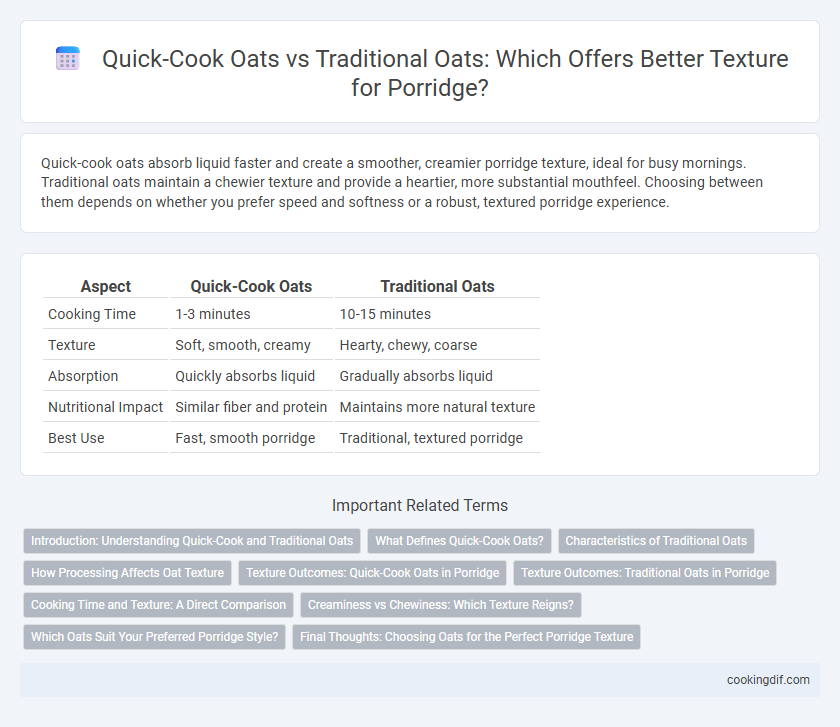Quick-cook oats absorb liquid faster and create a smoother, creamier porridge texture, ideal for busy mornings. Traditional oats maintain a chewier texture and provide a heartier, more substantial mouthfeel. Choosing between them depends on whether you prefer speed and softness or a robust, textured porridge experience.
Table of Comparison
| Aspect | Quick-Cook Oats | Traditional Oats |
|---|---|---|
| Cooking Time | 1-3 minutes | 10-15 minutes |
| Texture | Soft, smooth, creamy | Hearty, chewy, coarse |
| Absorption | Quickly absorbs liquid | Gradually absorbs liquid |
| Nutritional Impact | Similar fiber and protein | Maintains more natural texture |
| Best Use | Fast, smooth porridge | Traditional, textured porridge |
Introduction: Understanding Quick-Cook and Traditional Oats
Quick-cook oats are processed to cook faster, resulting in a smoother and creamier porridge texture compared to traditional oats, which retain their whole oat groat shape for a chewier, heartier consistency. Traditional oats absorb liquid more slowly, requiring longer cooking times but yielding a more substantial mouthfeel. Choosing between these oats depends on texture preference and cooking time constraints for preparing porridge.
What Defines Quick-Cook Oats?
Quick-cook oats are oat groats that have been steamed, rolled thinner, and cut into smaller pieces to reduce cooking time compared to traditional oats. This processing creates a finer texture that results in a creamier, softer porridge, ideal for fast preparation but with a less chewy bite than old-fashioned steel-cut or rolled oats. The reduced cooking time and altered structure define quick-cook oats, making them the preferred choice for convenience without sacrificing the essential porridge flavor.
Characteristics of Traditional Oats
Traditional oats retain their whole oat groat structure, resulting in a chewy and hearty texture when cooked into porridge. Their slower cooking time allows for gradual starch release, producing a creamier consistency compared to quick-cook oats. This texture is preferred by those seeking a more substantial and satisfying porridge experience.
How Processing Affects Oat Texture
Quick-cook oats undergo more extensive steaming and rolling, which breaks down the oat grains into thinner, smaller flakes that absorb water faster and produce a softer, mushier porridge texture. Traditional oats, such as old-fashioned rolled oats, retain a thicker, denser flake structure due to minimal processing, resulting in a chewier and heartier porridge consistency. The degree of processing directly alters the starch gelatinization rate and water absorption capacity, significantly impacting the final mouthfeel of the porridge.
Texture Outcomes: Quick-Cook Oats in Porridge
Quick-cook oats produce a smoother, creamier texture in porridge due to their finer processing and faster absorption of liquid. Traditional oats retain more chew and a heartier, coarser mouthfeel because they are less processed and take longer to cook. Choosing quick-cook oats results in a softer, more uniform consistency ideal for those preferring a velvety porridge experience.
Texture Outcomes: Traditional Oats in Porridge
Traditional oats produce a chewier, heartier texture in porridge compared to quick-cook oats, which tend to result in a softer, mushier consistency. The larger, less processed flakes of traditional oats absorb liquid more slowly, retaining more bite and structure during cooking. This textural quality enhances the overall sensory experience, offering a satisfying contrast to the creaminess of the porridge base.
Cooking Time and Texture: A Direct Comparison
Quick-cook oats significantly reduce cooking time to about 1-3 minutes, producing a softer, creamier porridge due to their thinner cut and pre-steaming process. Traditional oats, such as steel-cut or old-fashioned rolled oats, require 10-30 minutes of cooking, resulting in a chewier, nuttier texture with a heartier mouthfeel. The choice between quick-cook and traditional oats directly influences porridge texture and preparation efficiency depending on time constraints and desired consistency.
Creaminess vs Chewiness: Which Texture Reigns?
Quick-cook oats produce a creamier porridge texture due to their finer cut and faster water absorption, making them ideal for smooth, velvety bowls. Traditional oats offer a chewier bite and thicker consistency, preserving more of the oat's natural structure during cooking. Choosing between creaminess and chewiness depends on texture preference, with quick-cook oats emphasizing softness and traditional oats providing heartier mouthfeel.
Which Oats Suit Your Preferred Porridge Style?
Quick-cook oats produce a softer, creamier porridge with a smooth consistency, ideal for those who prefer a fast and easy breakfast. Traditional oats yield a thicker, chewier texture, satisfying individuals who enjoy a hearty, rustic porridge experience. Choosing between quick-cook and traditional oats depends on your preferred porridge style, balancing convenience against texture.
Final Thoughts: Choosing Oats for the Perfect Porridge Texture
Quick-cook oats produce a smoother, creamier porridge due to their finer, pre-steamed texture, while traditional oats create a thicker, chewier consistency with a more robust oat flavor. For those seeking a hearty and substantial porridge, traditional oats offer superior texture and depth, though they require longer cooking times. Selecting oats based on desired texture and cooking time allows for the perfect porridge tailored to individual preferences.
Quick-cook oats vs traditional oats for porridge texture Infographic

 cookingdif.com
cookingdif.com